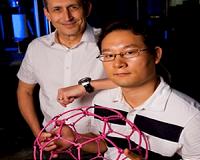 |
Gaithersburg MD (SPX) Aug 03, 2010 NIST researchers grow nanowires made of semiconductors-gallium nitride alloys-by depositing atoms layer-by-layer on a silicon crystal under high vacuum. NIST has the unusual capability to produce these nanowires without using metal catalysts, thereby enhancing luminescence and reducing defects. NIST nanowires also have excellent mechanical quality factors. The latest experiments, described in Advanced Functional Materials,* maintained the purity and defect-free crystal structure of NIST nanowires while controlling diameter and placement better than has been reported by other groups for catalyst-based nanowires. Precise control of diameter and placement is essential before nanowires can be widely used. The key trick in the NIST technique is to grow the wires through precisely defined holes in a stencil-like mask covering the silicon wafer. The NIST nanowires were grown through openings in patterned silicon nitride masks. About 30,000 nanowires were grown per 76-millimeter-wide wafer. The technique controlled nanowire location almost perfectly. Wires grew uniformly through most openings and were absent on most of the mask surface. Mask openings ranged from 300 to 1000 nanometers (nm) wide, in increments of 100 nm. In each opening of 300 nm or 400 nm, a single nanowire grew, with a well-formed hexagonal shape and a symmetrical tip with six facets. Larger openings produced more variable results. Openings of 400 nm to 900 nm yielded single-crystal nanowires with multifaceted tops. Structures grown in 1,000-nm openings appeared to be multiple wires stuck together. All nanowires grew to about 1,000 nm tall over three days. NIST researchers analyzed micrographs to verify the uniformity of nanowire shape and size statistically. The analysis revealed nearly uniform areas of wires of the same diameter as well as nearly perfect hexagonal shapes. Growing nanowires on silicon is one approach NIST researchers are exploring for making "nanowires on a chip" devices. Although the growth temperatures are too high-over 800 degrees Celsius-for silicon circuitry to tolerate, there may be ways to grow the nanowires first and then protect them during circuitry fabrication, lead author Kris Bertness says. The research was partially supported by the Defense Advanced Research Projects Agency (DARPA) Center on NanoscaleScience and Technology for Integrated Micro/Nano-Electromechanical Transducers (iMINT) at the University of Colorado at Boulder.
Share This Article With Planet Earth
Related Links NIST Nano Technology News From SpaceMart.com Computer Chip Architecture, Technology and Manufacture
 Nanomaterials Poised For Big Impact In Construction
Nanomaterials Poised For Big Impact In ConstructionHouston TX (SPX) Aug 02, 2010 Nanomaterials are poised for widespread use in the construction industry, where they can offer significant advantages for a variety of applications ranging from making more durable concrete to self-cleaning windows. But widespread use in building materials comes with potential environmental and health risks when those materials are thrown away. Those are the conclusions of a new study publ ... read more |
|
| The content herein, unless otherwise known to be public domain, are Copyright 1995-2010 - SpaceDaily. AFP and UPI Wire Stories are copyright Agence France-Presse and United Press International. ESA Portal Reports are copyright European Space Agency. All NASA sourced material is public domain. Additional copyrights may apply in whole or part to other bona fide parties. Advertising does not imply endorsement,agreement or approval of any opinions, statements or information provided by SpaceDaily on any Web page published or hosted by SpaceDaily. Privacy Statement |